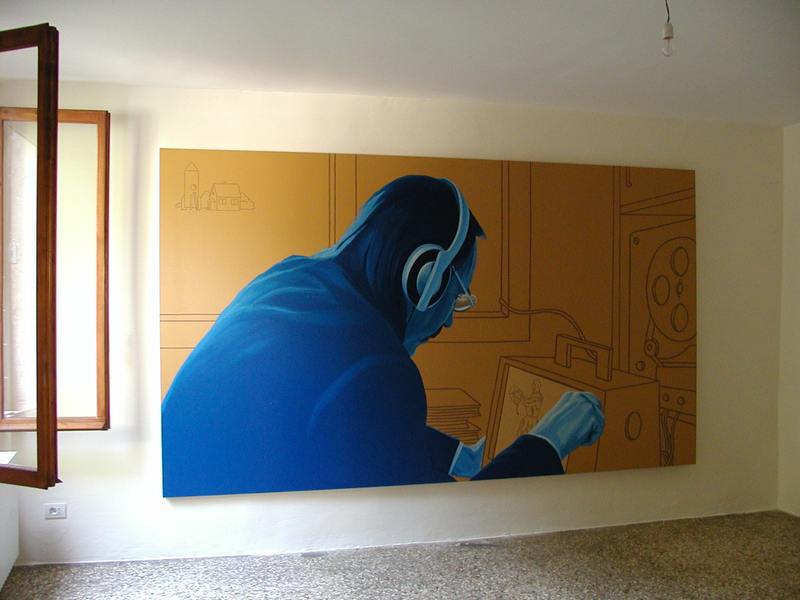
John Smith (artist duo Kaido Ole and Marko Mäetamm) represented Estonia at the 50th Venice biennial with a show called “Marko und Kaido”, curated by Anders Härm at Palazzo Malipiero.
Curator Anders Härm: “Yes, you are not mistaken – John Smith is the artist representing Estonia this year at the Venice biennial and the project is called “Marko und Kaido”.
John Smith, of course, is a fictional character. He is the constantly changing Conceptual Persona of two artists, Marko Mäetamm and Kaido Ole, who have for years shared a studio. Under these circumstances – working side by side – the third guy John with a third point of view was born.
We could recall here the statement of psychotherapist Felix Guattari: I and Deleuze never worked together, we were working somewhere in the space between us. Smith comes from the space between Ole and Mäetamm – he is the personified and schizo “uni-zone” as well as the working method of the artists. In contrast to, let’s say, Nietzsche´s Conceptual Persona Zarathustra, Smith is everything but the Übermensch. He is an … Idiot as if Deleuze´s and Guattari´s definition of this notion has been taken literally.
Freshman
As an artist John is a freshman, he started to participate in the exhibitions only few years ago. Smith´s first exhibition was the scandalous and fake “young British art” show at Tallinn Art Hall in 2001. (see Matthew Collings “Art Crazy Nation”, 21 Publishing Ltd, London, 2001, pp.6-7) It was the beginning of his success – the painting “Holocaust” from that exhibition was bought by the Estonian Art Museum at once.
Rapla
In Venice, John’s mysterious and permanently shifting persona becomes fixed at least for a minute. He reveals his secrets in the form of texts and paintings, which tell the autobiographic story: John is a German immigrant with Polish roots (sic!) who after long studies at the Goethe Institute in Stuttgart has become a gene technologist (sick?). The institute dispatched him to study “average people” in Rapla, a provincial city in provincial Estonia (back then a provincial country of the Soviet Union and the future province of the European Union). Working as an art teacher at the local secondary school he discovers two completely average boys – Marko and Kaido, who are strikingly similar with artists Mäetamm and Ole and who become the objects of his studies. He follows them for almost 40 years throughout their tremendously boring life. Smith becomes more and more suspicious of the meaningfulness of his work, and at some point he stops sending his reports to the institute in Stuttgart, where he has been in fact forgotten a long time ago. But soon after that something strange starts to happen in the backyard of Kaido and Marko´s house, where the boys live together. They embark upon building a rocket. Like some freaky brothers of David Bowie´s Ziggy Stardust, like Wallace and Gromit, they plan to leave the dusty Rapla behind and “run away to the stars”. Standing side by side with great men like Martin Luther King, Marko and Kaido could say as proudly: We had a dream!
There is no need to mention that their attempt was a failure…
Average salary
The “Space program” of Kaido and Marko is just as optimistic, infantile and idiotic a project as John Smith itself. We might even say that they form a conceptual whole. But behind that conceptualized “village madness” semi-autobiographical material of Mäetamm and Ole is brought out. Although alienated from it they are both small-town kids and very familiar with a provincial perception and ways of life. (Isn’t an art project a great way to get in touch with your roots, or what? They should have been already in Documenta!)
There is also a clear connection with the creative work of both artists – with Mäetamm’s series of everyday humour and with the bubble-headed guy from Ole´s paintings who, as described by the critics, is a “modern and flat citizen, who votes regularly in parliament elections, raises the mobile phone sale indices each year, and earns an average salary.”
Cool of painting
John’s themes are everything but cool, his style of painting, again, is nothing but the cool. His pictures have no quality we are used to calling “painterly”; it is pure image that counts. John’s pictures are painted by two artists, but they never reveal their “real” author. His handwriting is commonplace, but not hyperrealist, although no “inner tensions” or anything like that are revealed here. The cool of his paintings is in constant conflict with the subject, but the pathos of them could be that with some technical skills everybody could do them. So we might say that the art of John Smith is “everyman’s” art in every way.
Exhibition team
Artist: John Smith (Marko Mäetamm and Kaido Ole)
Curator: Anders Härm
Commissioner: Sirje Helme (CCA)
The exhibition was accompanied by a catalogue, texts by Anders Härm and Anti Randviir, editors Sirje Helme and Miriam McIlfatrick, designed by Andres Tali.
The project was selected with an open call. The members of the jury were Sirje Helme, Eha Komissarov, Tiiu Talvistu, Jaan Toomik, Andres Kurg, Jaan Elken and Hanno Soans.